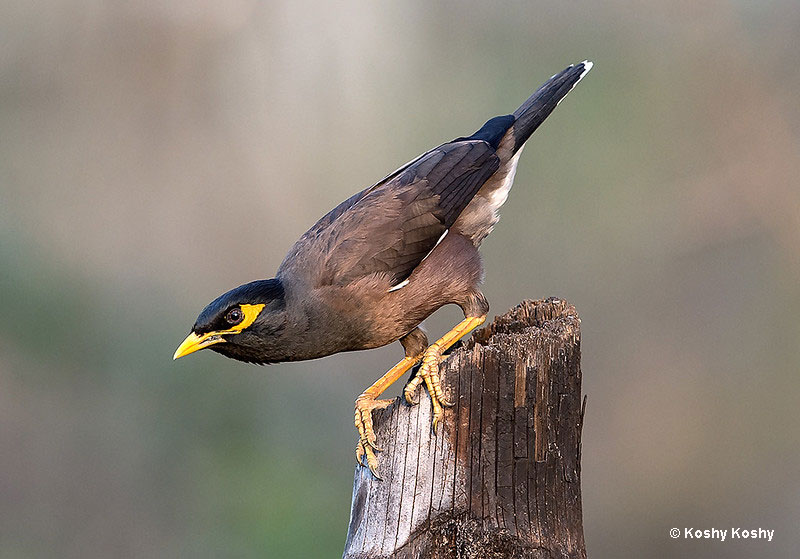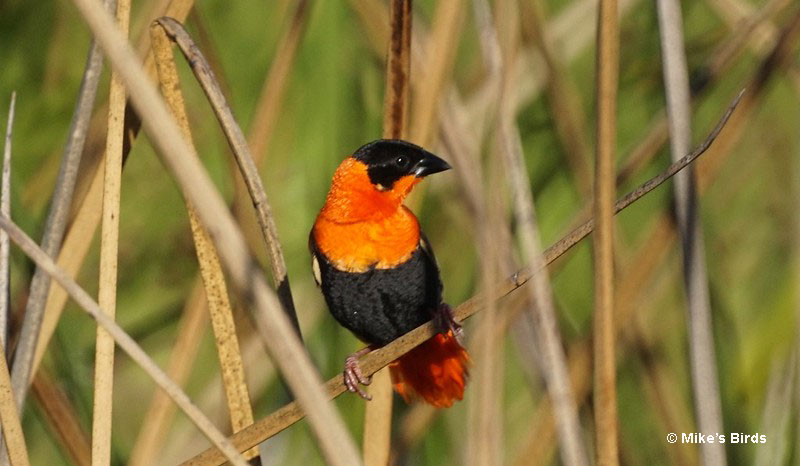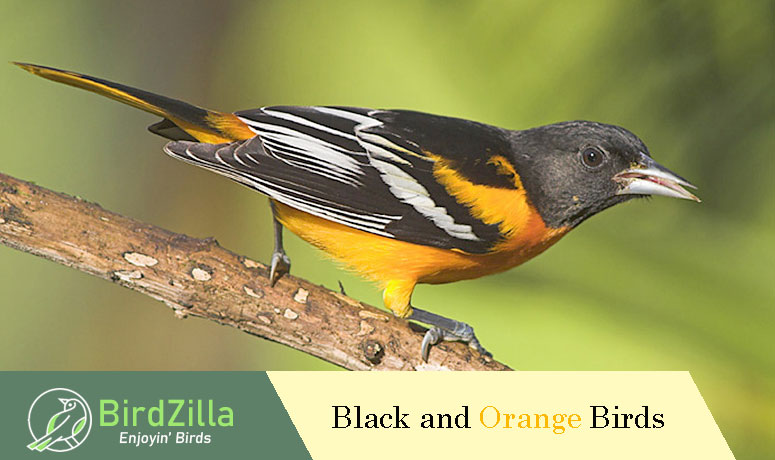
It can be hard to tell some black and orange birds apart, so how can we do that?
We’ve compiled a list of the most common black and orange birds as well as their descriptions to make identification easier! Some of these birds may be primarily black and orange, while others may only have sections of black and orange.
On this page
#15 Bullock’s Oriole
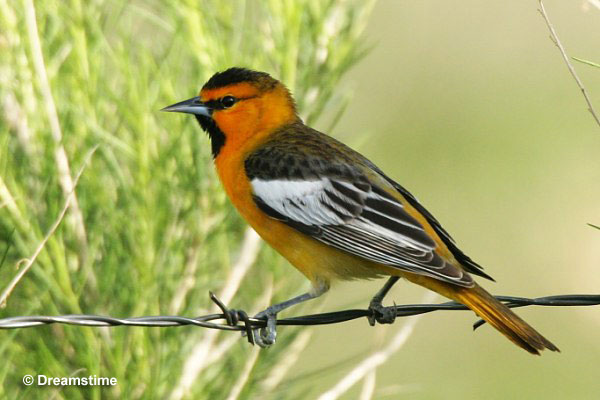
The Bullock’s Oriole is a medium-sized songbird with medium-long tails and sturdy but slender bodies. Bullock’s Orioles are related to blackbirds and share their thick-based, long, sharply pointed bills.
Adult male Bullock’s Orioles are vibrant black and orange birds with large white wing patches. Additionally, their throats are black, and their face is orange with a black line through the eye.
Immature males and females are yellowish-orange on the tail and head, have white-edged wing coverts, and grayish backs. Juvenile males show the black throat patch, while the females do not.
These orioles breed in open and riparian woodlands, including urban parks. They prefer areas where the trees are big and in isolated clumps or spaced apart.
They often nest in cottonwood, sycamore, deciduous oaks, willow, large mesquite, and madrone trees.
These birds also use pecan, live oak, salt cedar, orchard, and conifer trees, but it’s less likely than the ones listed previously. Bullock’s Orioles gravitate toward trees that are larger than the ones used by Orchard Orioles. Both of these birds inhabit similar habitats like open woodland during winter and migration.
#14 Western Tanager
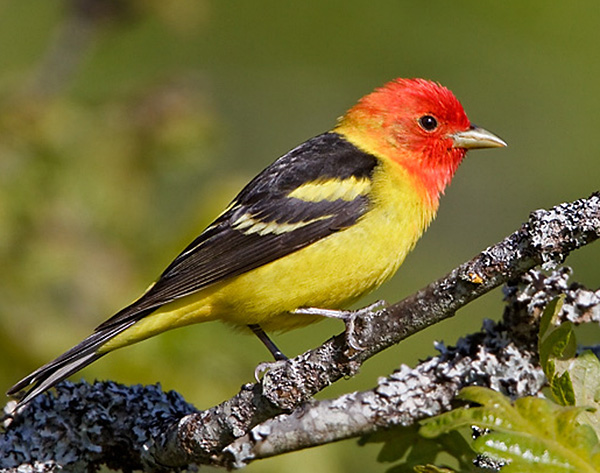
The Western Tanager is a relatively small and stocky songbird. However, they are noticeably heavier-bodied and larger than warblers. They have medium-length tails and thick-based, short bills. Western Tanagers are smaller than American Robins and larger than Yellow Warblers.
Breeding male Western Tanagers have black wings, are yellow overall, and have flaming orange-red heads. Their wings have 2 bold wingbars, the lower one being white and the upper one being yellow. Their tails and backs are black as well.
Female Western Tanagers are yellow-green overall and have pale red restricted to the front of their faces. Immature males lack the red in the face during the fall months. In spring, they have red on their face but it’s less than what’s seen on breeding adults of the respective sex.
Western Tanagers breed in mixed coniferous-deciduous and open coniferous woodlands up to around 10,000 feet elevation in the western portions of North America. These birds are common in forests with lodgepole pine, ponderosa pine, and Douglas-fir trees.
They’re also known to breed in aspen forests, riparian woodlands, pinyon-juniper, and oak woodlands. They generally favor open woods, including forest edges, gardens, suburban parks, and wetlands.
During their migration, Western Tanagers are more likely to inhabit a wider variety of areas, including woodland, forest, partly open habitats, scrub, and human-made environments such as parks, orchards, suburban areas, and gardens. Their winter habitats in Central America and Mexico usually involve forest edges and pine-oak woodland.
#13 Eastern Towhee
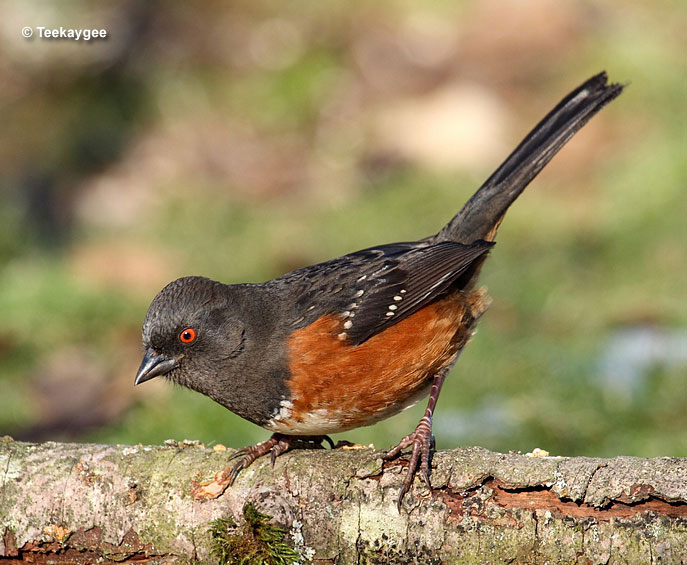
Eastern Towhees are large sparrows. They have thick-based, triangular bills that are perfect for cracking seeds. This kind of bill is a tell that you’re looking at a bird that’s part of the sparrow family. Additionally, they have long, rounded tails and chunky bodies. These birds are smaller than a robin, twice as heavy, and 30% larger than a Song Sparrow.
Male Eastern Towhees are striking with their warm rufous sides, white belly, and bold sooty black back and breast. Female Eastern Towhees look almost identical to breeding males but are dark brown, whereas the males are black.
Eastern Towhees are commonly found in overgrown fields, forest edges, overgrown woodlands, scrubby backyards, and thickets. Therefore, it’s crucial that the areas they inhabit have dense shrubbery for cover and plenty of leaf litter for them to scratch around in.
These birds can even be seen in the Appalachian mountains to about 6,500 feet, but they will favor dry and warm south-facing slopes over the moist and cool northern faces.
#12 Varied Thrush
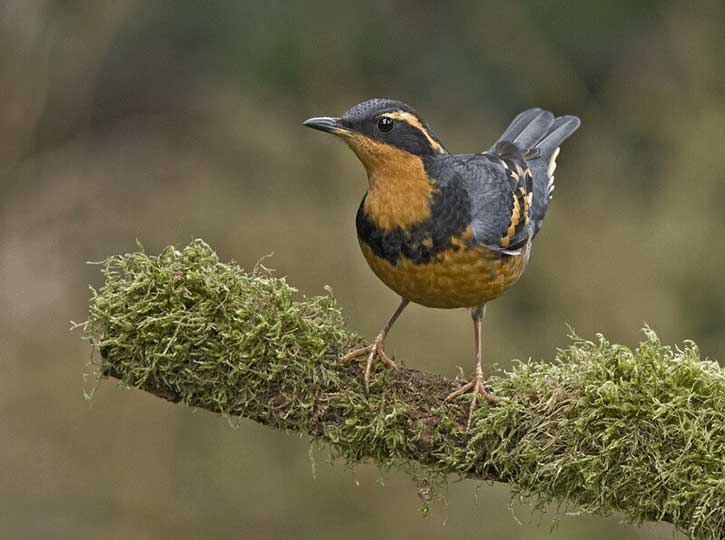
Varied Thrush © Alan Wilson
The Varied Thrush is a stocky songbird with long legs, straight bills, and large, rounded heads. They can usually be seen standing horizontally in a tree or on the ground. Their bellies often look plump, and they have reasonably short tails. Varied Thrushes are about the size as robins.
See more: Birds with orange chests
Male Varied Thrushes are known as birds with rich black and orange plumage.
The wings have orange edging on their flight feathers and are blackish with 2 orange bars. Females look almost identical but are paler than breeding males.
These birds live in wet, dark mature forests in the Pacific Northwest in the United States, western Canada, and Alaska. In their breeding range, they inhabit forests dominated by Sitka spruce, coastal redwood, red alder forests, western red cedar, western hemlock, Douglas-fir, and western larch.
In the winter months, these birds can be found in a broader range of habitats, including gardens, parks, lakeshores, and riparian areas where berries and fruit are in abundance.
#11 Hooded Oriole
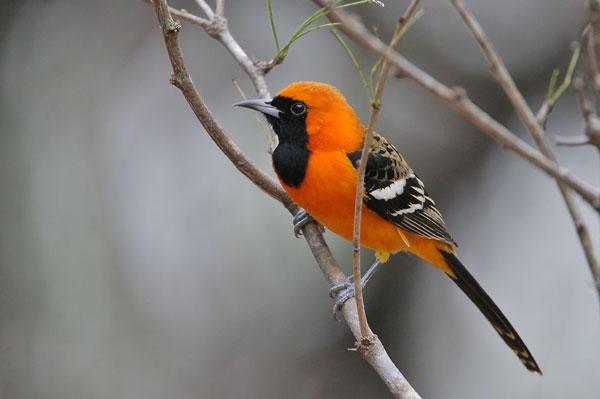
Photographs © Greg Lavaty.
Hooded Orioles are relatively large songbirds that have more delicate bodies and are longer than other orioles. Additionally, they have longer necks and rounded, long tails. Their bills have a slight downward curve.
Adult male Hooded Orioles are vibrant black and orange birds. Their plumage can vary from flame orange to bright yellow. They have black wings, throats, and tails, as well as yellow to orange wings, rumps, bellies, and hoods.
The black on their throat extends up into the face, which creates a small mask around the eye and down into the chest. Adult males also have white wingbars. Juvenile males are olive-yellow overall, have slim white wingbars, grayer backs, and black throats. Females look similar but lack the black throat.
Hooded Orioles live in dry, open areas in the Southwestern portions of the U.S. and Mexico. They inhabit areas that have scattered trees like willows, cottonwoods, palm, and sycamore trees.
#10 Blackburnian Warbler
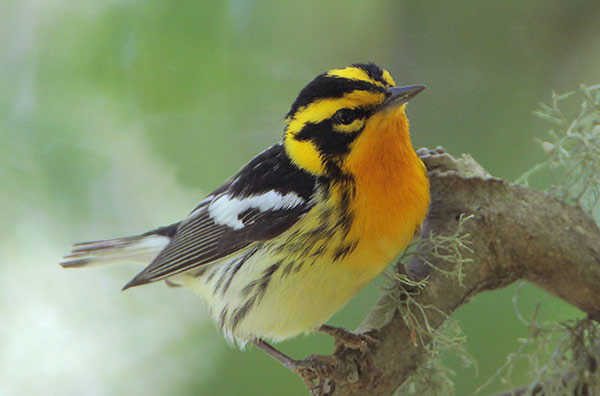
Blackburnian Warblers are medium-sized birds that have pointed, thin, short bills, and medium-length tails. They’re slim and have a shape that’s similar to the common Yellow Warbler. They’re smaller than a Yellow-rumped Warbler and larger than a Northern Parula.
Breeding male Blackburnian Warblers are unmistakable with their bright orange throats and faces. Immature males and females have small portions of this coloration. All birds have the unique triangular facial pattern of gray or black.
Blackburnian Warblers inhabit mixed coniferous-deciduous forests and mature coniferous forests in North Carolina and Virginia. They’ll nest in pure deciduous forests in the southernmost portions of their breeding range.
Black, white, and red spruce forests across the southern portions of the boreal forest belt have Blackburnian Warbler nesting populations, as do forests containing yellow birch, white pine, and balsam fir.
Singing males often choose to perch at the very top of the tallest spires of balsam fir or spruce trees to sing their songs. This preference makes them easy to spot in such habitats.
During the fall migration, these warblers can be found traveling with other warblers on well-forested mountainsides. They move quickly up or down slopes in search of insects to fuel them for the rest of their migration. In lowlands, migrant birds can turn up in a variety of wooded habitats, even fairly low-stature edges or second-growth.
On the coast, Blackburnian Warblers can sometimes be seen foraging for food in shrubs near the ground. Birds that migrate in the spring can also be found in a variety of habitats, especially if they have just came down from nocturnal migration and have not become familiar with their surroundings.
#9 Altamira Oriole
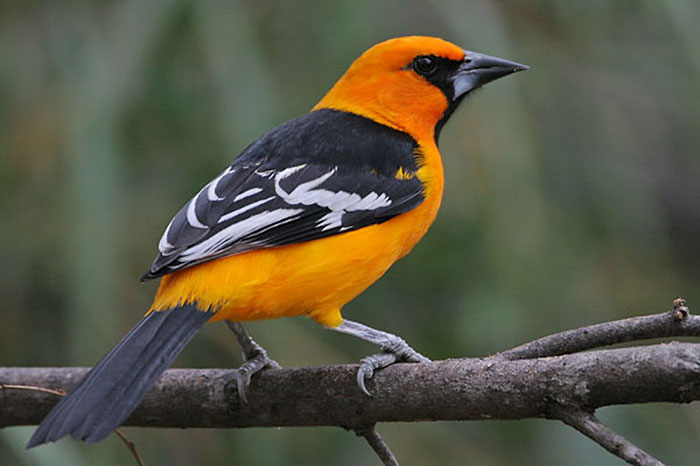
The Altamira Oriole is a large songbird with relatively large heads, long tails, and stocky bodies. Their bills are very thick at the base but sharply pointed and rather long.
Adult male Altamira Orioles are beautiful black and orange birds. The brightest orange is on their face. They have black on their chins and in front of their eyes, black tails, black wings, and black backs. Additionally, they have orange shoulders and white wingbars.
Immature breeding males are yellowish-orange overall, have olive-brown backs, and don’t have orange shoulder marks. Juvenile birds have yellow bodies and heads, olive backs, and lack the chin markings, dark face, and wing markings.
In the U.S., these orioles are year-round residents in lightly wooded areas of the Rio Grande Valley in Texas. This area has been steadily developed and have very small amounts of remaining natural habitat.
However, this species is still relatively common in thorn forests, riparian corridors, well-wooded suburbs, wooded parks, orchards, wildlife refuges, and farms. Farther south, in Central America and Mexico, Altamira Orioles can be found in a lot of forested habitats from the coastal plain up to nearly 5,000 feet in elevation.
#8 American Redstart
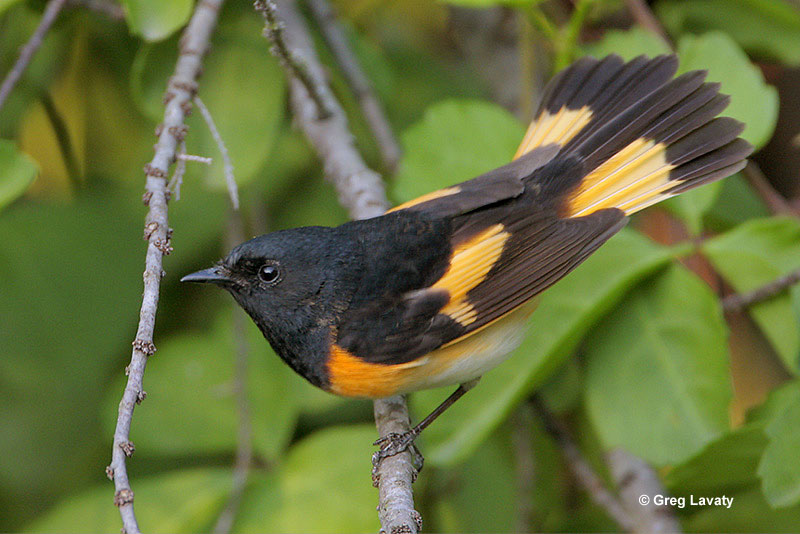
American Redstarts are medium-sized warblers with relatively broad, flat bills and rather long tails. However, when these birds are in flight, their slim bellies, long, club-shaped tails, and deep chests can be seen.
Adult male American Redstarts are black overall, with bright orange patches on their tails, wings, sides, and white bellies. Immature males and females are more yellow to yellow-orange. They have dark-gray tails, gray heads, gray underparts, and olive wings and backs.
During the breeding season, American Redstarts inhabit second-growth, moist, deciduous woodlands that have an abundance of shrubs across most of the northern and eastern portions of the United States and southern Canada.
The areas they inhabit are often positioned near water and include willow and alder thickets, fencerows, thickets in treefall gaps within old-growth forests, mixed deciduous-coniferous woodlands, and orchards.
In the western portions of their range, these birds use coniferous forests, thickets, and riverside woods. They spend their winters in mid- to low-elevation forests in California, southern Florida, southern and western Mexico, the Caribbean, northern South America, and Central America.
Their wintering habitats include shade coffee plantations, mangroves, citrus plantations, wet forests, isolated trees in residential urban areas, and scrub thickets.
#7 Vermilion Flycatcher
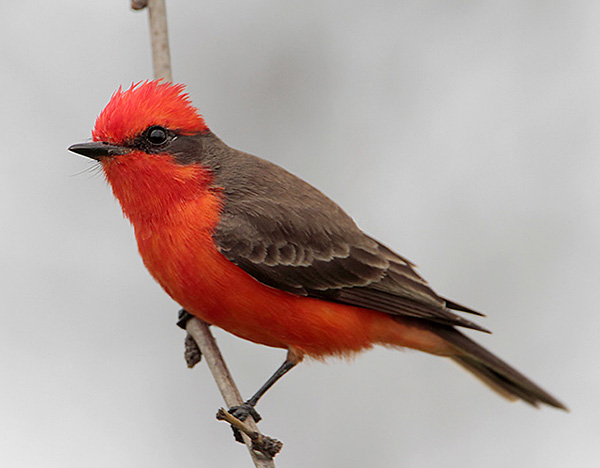
The Vermilion Flycatcher is a stocky yet small songbird. They’re known for their upright posture, barrel chests, flat heads, wide, straight bill, and slim tails. They’re smaller than an Ash-throated Flycatcher and larger than a Blue-gray Gnatcatcher.
Adult male Vermilion Flycatchers are a beautiful orange-red, have dark brown masks and brown tails, wings, and backs. Immature males and females are gray-brown overall, have a salmon-red blush on their underparts, and faint streaks on the breast. Their bills are black.
Vermilion Flycatchers can be found in open country in the southern portions of the United States and Mexico. They prefer to inhabit canyon mouths, arid scrublands, deserts, parks, and farmlands in all seasons.
They heavily rely on stream corridors inside of scrub ecosystem, where sycamore, willow, mesquite, and cottonwood trees grow.
#6 Black-Headed Grosbeak
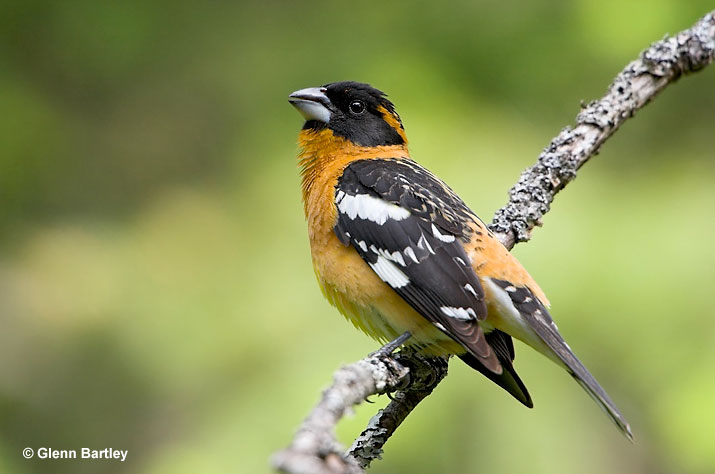
Black-headed Grosbeaks are heavy-set songbirds that have very large bills. Their bills are thick at the base and conical. Additionally, they have thick, short necks, large heads, and short tails. They’re smaller than an American Robin and larger than a House Finch.
Breeding male Black-Headed Grosbeaks have black heads, black-and-white wings, and are rich orange-cinnamon overall.
Immature males and females are warm orange on the breast and brown above. Some have stripes on the sides of the breast. Breeding males, females, and immature males all have grayish bills. Additionally, bright yellow can be seen under the wings when in flight.
These grosbeaks breed in habitats that give them easy access to water and have a wide variety of plants. They avoid stretches of unbroken desert, dry chaparral, grassland, and dense coniferous forests.
Instead, they inhabit edges of habitats that meet others or are disturbed. Black-Headed Grosbeaks winter in areas that are either subtropical or tropical in Mexico.
When migrating, they tend to look for trees and shrubs that have an abundance of berries.
#5 Common Myna
Common Mynas are black-and-brown birds with yellow legs, yellow bills, and white wing patches. Although they don’t look orange at first sight, they have interesting yellowish-orange spots underneath their eyes.
These birds are very social and are often found in noisy flocks. Additionally, they can be very aggressive and are known to drive other birds away. Common Mynas can be found almost anywhere but dense forests.
These birds are native to southern Asia and are popular cage birds. Common Mynas have established feral populations in many parts of the world, including South Florida. All birds that are wild outside of Southern Asia are all escapee birds. Many populations thrive in suburbs and cities.
#4 American Robin
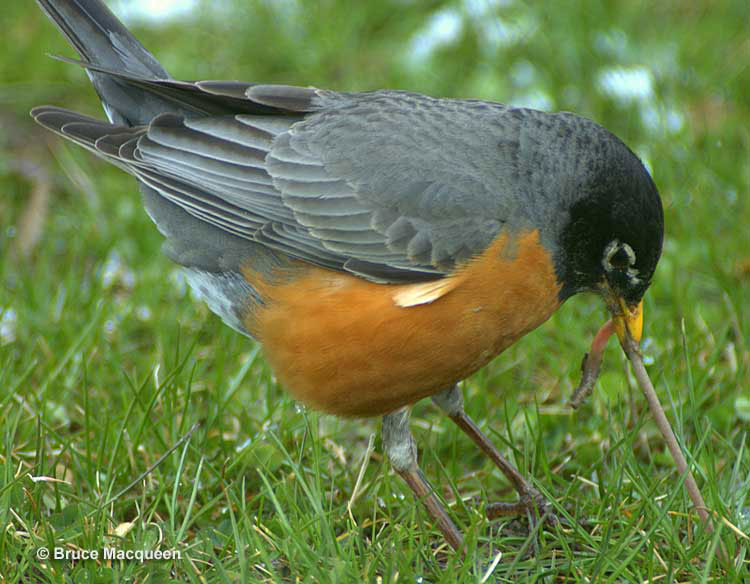
American Robins are relatively large songbirds with rounded, large bodies, rather long tails, and long legs. They’re the largest thrush in North America and are almost half the size of a bluebird.
These birds are gray-brown overall, dark heads, and are warm orange on their underparts. When in flight, a white patch can be seen under their tails and lower bellies. Females look similar to males but have paler heads that contrast less with the gray back.
American Robins can be seen across all of North America. You can see them in city parks, lawns, and fields. When they’re not in these places, you can find them in more wild places like forests, woodlands, mountains up to the tree line, tundra, and recently burned forests.
During the winter months, a lot of robins move to woods where berry-producing shrubs and trees are abundant.
#3 Baltimore Oriole
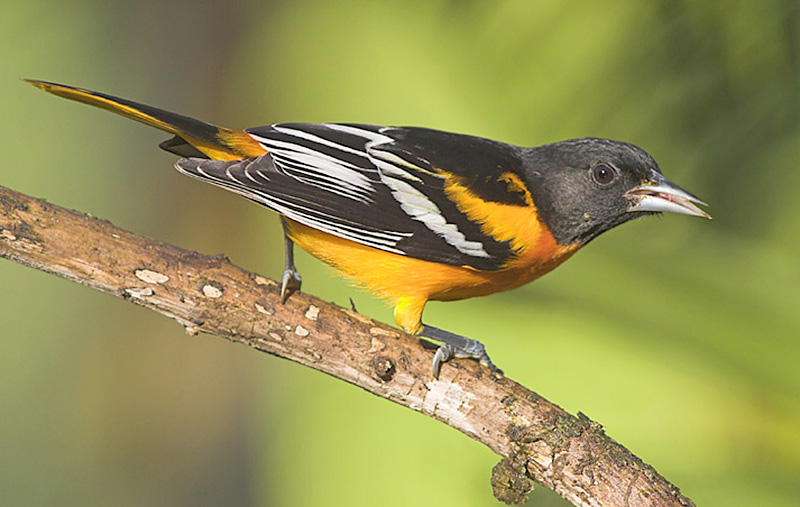
Baltimore Orioles are sturdy-bodied, medium-sized songbirds. They have long legs, thick necks, and thick-based, long, pointed bills. They’re about the same size as a Red-winged Blackbird but are more slender.
Adult male Baltimore Orioles are black and flame-orange. They have solid-black heads, black wings, and 1 white bar on their wings. Juvenile males and females are grayish on the back and head, yellow-orange on the breast, and have 2 bold white wing bars.
You can find Baltimore Orioles high up in leafy deciduous trees in their breeding range in the eastern portions of the United States. However, you won’t find them in deep forests; they prefer forest edges, open woodland, small groves of trees, and river banks.
Baltimore Orioles forage for fruits and insects in shrubbery and brush. These birds have adapted exceptionally well to humans and usually nest and feed in backyards, orchards, and parks.
They winter in Central America, where they occupy gardens, open woodlands, and shade-grown cacao and coffee plantations. These birds love to visit flowering vines and trees, often in search of nectar and fruit.
#2 Northern Red Bishop
Northern Red Bishops are popular cage birds. They’re native to Africa, but escapee birds have been able to establish nesting populations in Texas in the Houston area and coastal southern California. Escaped birds have even been seen elsewhere in places like Florida and Puerto Rico.
These birds are very social and form flocks of tens to hundreds. Northern Red Bishops are often found in open habitats, including the edges of marshes and agricultural areas.
Breeding males have black crowns, black faces, long reddish-orange upper tail coverts, and brown wings.
Females and nonbreeding males look similar to the Black-winged Bishop, but they’re smaller in size and have smaller bills.
#1 Orchard Oriole
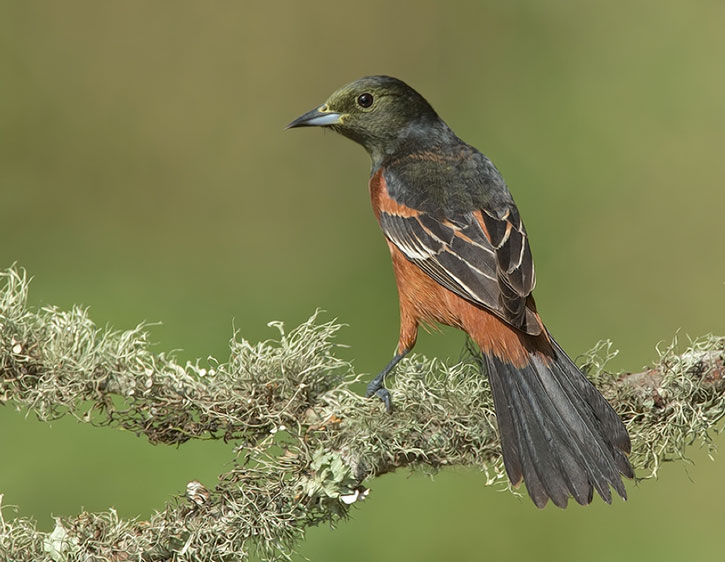
Orchard Orioles are slender songbirds with round heads, medium-length tails, and sharply pointed, straight bills.
Adult male Orchard Orioles are rich reddish-chestnut below and black above. They have a reddish-chestnut spot at the bend of the wing and black heads and throats. Female Orchard Orioles are yellow-green, have no black, and 2 white wing bars. Juvenile males look similar to females but have black around the throat and bill.
These birds inhabit open woodlands along marsh edges, river edges, lakeshores, farms, and shrublands. They nest in scattered trees, including large trees that have been planted for shade.
In addition, these orioles winter in tropical forest edges, thickets, plantations, lightly wooded areas, and shady pastures—at a variety of elevations up to a mile or more above sea level.


